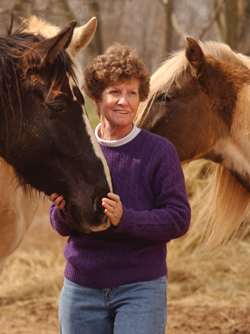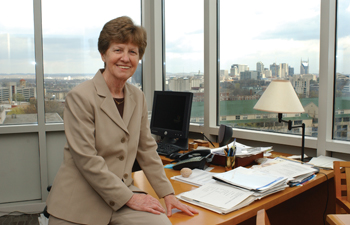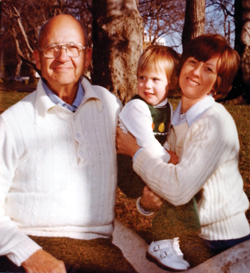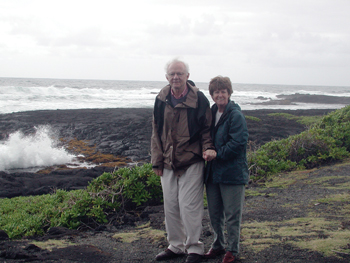
Elaine Sanders-Bush, Ph.D., at her farm in Olmstead, Ky.
Photo by Dana Johnson
Scientific mother: Sanders-Bush relishes sharpening science by nurturing inquiring minds

Elaine Sanders-Bush, Ph.D., director of the Vanderbilt Brain Institute, in her office in MRB III.
Photo by Dana Johnson

Sanders-Bush with daughter, Kate, and first husband Milton Bush, Ph.D.

Sanders-Bush and current husband Steven Mayer, Ph.D., on vacation in Hawaii.

Sanders-Bush, daughter, Kate Loyco, and Grace the dachsund out for a stroll on the family farm.
Photo by Dana Johnson
Elaine Sanders-Bush, Ph.D., doesn't talk a lot about her achievements.
Professor of Pharmacology and Psychiatry at Vanderbilt University School of Medicine, and Director of the Vanderbilt Brain Institute, Sanders-Bush will be installed next month as president of the American Society for Pharmacology and Experimental Therapeutics (ASPET), one of the world's oldest and most prestigious science organizations.
“She's very modest,” said her sister, Judi Silvey. “Unless we really drill her, we don't know anything that's going on … She wants us to know her for Elaine, not for what she's done.”
Her colleagues describe her as direct and tenacious, an iconoclastic thinker whose work has contributed significantly to current understanding of how the brain works. Yet this energetic, clear-eyed woman, who has devoted a good part of her career to mentoring young scientists, is also distinguished by her generosity, loyalty and integrity.
“Her tenacity is not expressed in noise and banging on tables,” said Lee Limbird, Ph.D., former chair of Pharmacology at Vanderbilt and a longtime colleague. “It's just an unswerving compass: a scientific compass, an ethical compass, a moral compass, a commitment-on-behalf-of-others compass.”
Sanders-Bush's journey to the top echelons of science began along the country roads in Olmstead, Ky. Her father, Thomas Lee Sanders, raised tobacco, corn and wheat, and passed on his enthusiasm for the outdoor life to his three children.
Neither of their parents graduated from high school, but their mother, Lucille, went to work in a factory in nearby Russellville so her older children — Dale and Elaine — could fulfill their dreams of going to college.
At first, Sanders-Bush, one of 24 seniors in the class of '58 at Olmstead High School, wanted to become a teacher. She switched to science while attending Western Kentucky State College in Bowling Green (now Western Kentucky University) — thanks in part to the encouragement of Biology Department head Henry LeRoy Stephens, Ph.D.
“I was good in science. I liked it a lot,” she said. “I guess (Stephens) recognized I had potential, and encouraged me to think about graduate school.”
In her junior year a Vanderbilt professor, Milton Bush, Ph.D., came to talk to students about pharmacology. “Ooh, this is fascinating — a combination of biochemistry and physiology,” she recalled thinking. So she applied, and was admitted to Vanderbilt.
Bush, who later would become her husband, was her graduate adviser. “He was a remarkable person, so innovative,” Sanders-Bush said. “He just made (pharmacology) interesting and exciting.”
Bush had lost his left arm as a child, but he didn't let that slow down his science or his social life. He coached the Vanderbilt tennis team in the 1950s, and went on to become a nationally ranked player in the senior circuit. He died from a heart attack while participating in a tennis tournament in 1984.
“He could put a lot of 'junk' on the ball … 'English,' spins,” recalled former Ophthalmology Chair James H. Elliott, M.D., who played doubles with Bush. “He wasn't an overpowering player, but he had great accuracy on his shots.”
“All of us had a wonderful time with 'Doc' Bush,” added Anderson “Andy” Spickard Jr., M.D., a former Vanderbilt tennis player and medical director of the Vanderbilt Center for Professional Health. At that time, there were no tennis scholarships, but in the spring of 1953, Spickard's senior year, Bush cajoled an alumnus to fund a road trip to New Orleans.
“We were poor as Job's turkeys,” Spickard said. “We played LSU and Tulane … but the highlight was going to Arnaud's (restaurant), all of us sitting around there eating oysters on the half shell and eggs Benedict. We were on top of the world.”
A forward-looking place
Sanders-Bush earned her Ph.D. from Vanderbilt in 1967, and married a year later.
About the same time, she began a post-doctoral fellowship with Fridolin Sulser, M.D., one of the pioneers in the fledgling field of psychopharmacology.
“He was a great mentor,” she said. “I could immediately establish some independence and identity … He allowed me to go to international meetings to talk about my research. Not everyone does, or did in those days.”
“She was my first post-doc, and my best one,” responded Sulser, professor emeritus of Psychiatry and Pharmacology. “She had this ability to ask pertinent questions, which is very important in research, but then she also had the ability to develop methodology — to answer the questions.”
While working in Sulser's lab, Sanders-Bush discovered that a widely studied compound, p-chloroamphetamine, causes long-lasting depletion of the brain chemical serotonin by irreversibly inhibiting an enzyme involved in serotonin synthesis.
Serotonin plays an important role in brain functions as diverse as mood, appetite and memory, and has been implicated in a number of psychiatric diseases, notably depression, schizophrenia and bipolar disorder.
Her report, among the first to describe how serotonin levels can be chemically manipulated, “got a lot of press,” Sanders-Bush recalled. “People at first didn't believe it; didn't think it was possible … I remember arguing with one of the really prominent Italian scientists (at an international meeting) … That was an exciting time for us.”
“This,” quipped Sulser, “is when her love affair with serotonin started.”
In 1969, Pharmacology Chair Allan Bass, M.D., who'd recruited Sulser from the pharmaceutical company Burroughs Wellcome, invited Sanders-Bush to join the faculty — an offer that would prove to be pivotal to her career.
“In those days, there weren't a lot of women around (in pharmacology),” Sanders-Bush said. “Dr. Bass had a major influence on me throughout my graduate career, and as I developed into a faculty member, he had confidence in me … so he gave me that opportunity.”
Sanders-Bush joined Sulser and his team at the Tennessee Neuropsychiatric Institute, which had recently been established at the old Central State (Psychiatric) Hospital on Murfreesboro Road.
The accommodations weren't exactly pristine; the first research lab was set up in a dingy former hydrotherapy room. For Sanders-Bush, however, the environment was exhilarating. She was surrounded by a dynamic group of scientists who were doing fascinating and important work.
“We were right in the midst of it,” she recalled. “It was a really forward-looking place. It was really good for science.”
In September 1975, three months after the birth of her daughter, Kate, she bundled up the infant and flew to Stockholm for a sabbatical at the renowned Karolinska Institute. “That was the easiest time (for a sabbatical),” Sanders-Bush recalled, “because she wasn't walking. So it was safe to take her into the lab.”
Scientific “mother”
Today, 30 years later, Kate Loyco, who recently moved back to Nashville with her husband after several years in Virginia, remembers her parents being “very hands-on.”
Loyco described her mother as “very disciplined,” regularly logging 11-hour workdays, but added that she's also very attentive and gives generously to her family. “My mom is such a cool lady,” she said. “I'm really grateful for that.”
Scientific research “waxes and wanes,” and by the late 1970s Sanders-Bush realized she was “re-plowing old ground.” So she turned her attention to serotonin receptors, proteins that bind the neurotransmitter and through which it acts.
In the early 1980s, Sanders-Bush and others around the country, notably Johns Hopkins' Solomon Snyder, M.D., discovered there were two serotonin receptors. “Then the research just took off,” she said. “We made many, many significant contributions to (understanding) signaling in the early days.”
Among them: the discovery with then-graduate student Jeff Conn that some serotonin receptors exert their effects through a lipid signaling pathway.
Understanding the pathways through which brain chemicals send their signals is crucial for understanding how anti-psychotic drugs work, for example. It also is aiding the search for newer, more effective drugs that have fewer side effects.
Conn said he was attracted to the Sanders-Bush lab because of her multi-disciplinary approach to science, her high energy and excitement, and the independence she offered to her students.
Instead of assigning him to work on one of her high-priority projects, Conn said she encouraged him to read widely in the field, figure out what he wanted to do, and then “come back to me and talk about it.” It's rare to give graduate students that kind of “ownership” of their projects, he added.
After earning his Ph.D. in 1986, Conn worked at Emory University and at Merck Research Laboratories, where he led the neuroscience program for several years before returning to Vanderbilt in 2003.
A professor of Pharmacology, he directs that department's Program in Translational Neuropharma-cology, as well as the Vanderbilt Institute of Chemical Biology's drug discovery program.
“He is one of the innovators in that field,” Sanders-Bush said. “I'm just so proud of him.”
When told of her comment, Conn responded with a big smile. “There's something about your scientific 'mother,'” he said. “More than just about anything else, you like to make them proud.”
During the mid-1980s, following her first husband’s death, Sanders-Bush met and fell in love with Steven Mayer, Ph.D., a prominent pharmacologist from the University of California, San Diego, who was on sabbatical in the Limbird lab.
“I never thought I'd get married again,” she said. “Everything just happens.”
Mayer joined the Vanderbilt faculty as a research professor and retired in 1994 after developing Parkinson's disease.
Meanwhile, the scientific discoveries continued to pile up. With another graduate student, Eric Barker, now on the faculty at Purdue University, Sanders-Bush discovered that one of the serotonin receptors could “turn on” even in the absence of its neurotransmitter.
“It's just spontaneously active, which was kind of heresy in pharmacology,” she said. “Again, it was serendipity and we followed our noses and got really convincing data … Ultimately, many receptors have been discovered to have this kind of activity.”
A diversity of passion
In the mid-1990s, Sanders-Bush and Ronald Emeson, Ph.D., the Joel G. Hardman Chair in Pharmacology, discovered that another fundamentally important phenomenon, RNA editing, modulates a particular serotonin receptor involved in the action of anti-depressants and anti-psychotic drugs, and which also has been implicated in obesity.
This finding “has really catapulted her into national prominence,” said Randy Blakely, Ph.D., director of the Vanderbilt Center for Molecular Neuroscience.
Normally the genetic code, contained in the DNA, is transcribed into RNA which, in turn, is translated into a specific protein. In some cases, however, the RNA is altered or “edited” in a way that yields a slightly different protein.
“The RNA editing process, Elaine showed, not only changed the protein but it also changed how well the receptor works,” Blakely said.
“This work has implicated RNA editing as a potential mechanism through which behavior could be altered,” he said. “It is particularly relevant to depression, since the particular receptors she has studied are involved in the response to antidepressants. The editing mechanism may thus be a target for novel antidepressant medications.”
During the past few years, Blakely, Sanders-Bush and Vanderbilt psychiatrist Richard Shelton, M.D., have joined forces in a collaboration they call “Blues' Clues” to study the genetics of signaling in the brain. The aim is to understand the role that genetic variation may play in depression, in response to medication and in the risk for developing mental illness.
Sanders-Bush began her work when “we didn't even know what the targets in the brain were for many drugs,” Blakely said. In those days, it was as if “we were trying to cut diamonds with butter knives.”
Now, thanks to the genomic revolution, “we're able to start tackling the very complicated issues of what subtle genetic variation in these targets does for processes as broad as addiction and depression … Elaine's career has tracked that progression. She sharpened the blade.”
For many years, Sanders-Bush has taught and served on dissertation committees at historically black Meharry Medical College. At Vanderbilt, she cultivated support for the establishment in 1998 of an interdisciplinary doctorate program in neuroscience — which she directs.
Two years later, the program became part of the new Vanderbilt Brain Institute, which now includes nearly 300 scientists from more than 50 departments, centers and institutes across the Vanderbilt campus, and which communicates neuroscience discoveries through a variety of public outreach programs.
Sanders-Bush was interim chair of the Department of Pharmacology from 1999 to 2000, and she has contributed to her field through service on pharmacology journal editorial boards and national research review committees. Perhaps closest to her heart: the nurturing of graduate students, post-doctoral fellows and young faculty.
“They keep you thinking,” she said. “Watching them go from nascent scientists to independent scientists is a fascinating thing to do.”
“I credit her entirely with helping me reactivate my research program,” said Sanika Chirwa, M.D., Ph.D., associate professor of Neurobiology and Neurotoxicology at Meharry, and adjunct associate professor of Pharmacology at Vanderbilt.
Chirwa, who spent a sabbatical in the Sanders-Bush lab in 2001, is president of the Middle Tennessee Chapter of the Society for Neuroscience.
“Dr. Sanders-Bush continues to provide me with invaluable research guidance and mentorship,” he said. “It is not an exaggeration to say that she epitomizes the very best in a scientist and a leader.”
Diversity is also important to Sanders-Bush, who “grew up” in a scientific world dominated by white men, noted Limbird, currently Vice President for Research at Meharry.
“When you don't have a diversity of people participating (in science), you have fewer points of view and fewer passions,” she said. “Everything is served by increasing the diversity of passions.”
Next month Sanders-Bush will become the fifth pharmacologist with Vanderbilt ties to serve as ASPET president: her mentor Allan Bass, M.D., her husband, Steven Mayer, Ph.D., Sydney Spector, Ph.D., and former Pharmacology Chair Joel Hardman, Ph.D., were there before her.
In anticipation of her new position and anxious to begin a new chapter in her life, Sanders-Bush currently is downsizing her lab. “I want to be more than Elaine the scientist,” she said simply.
That doesn't necessarily mean she's going to slow down, however.
This winter Sanders-Bush and her daughter started an exercise class together. On the first day it snowed. “Everybody is hunkered down … but not Elaine. Elaine's at the gym,” Loyco said, laughing.
“I know I'm not going to miss a workout, because she's going to be there.”













